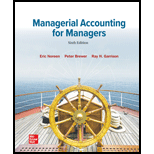
1.
Introduction: The difference in costs between the variable alternative is used to calculate financial advantage and disadvantage.
The direct labor-hour used in manufacturing one unit of each product.
2.
Introduction: The difference in costs between the variable alternative is used to calculate financial advantage and disadvantage.
To compute: The variable overhead costs incurred to manufacturing one unit of each product.
3.
Introduction: The difference in costs between the variable alternative is used to calculate financial advantage and disadvantage.
The contribution margin for all the products.
4.
Introduction: The difference in costs between the variable alternative is used to calculate financial advantage and disadvantage.
The highest total contribution.
5.
Introduction: The difference in costs between the variable alternative is used to calculate financial advantage and disadvantage.
To compute: The highest labor rate
6.
Introduction: The difference in costs between the variable alternative is used to calculate financial advantage and disadvantage.
To identify: The change that the company could make to enable it to satisfy the customer.
Want to see the full answer?
Check out a sample textbook solution
Chapter 6 Solutions
Loose Leaf For Managerial Accounting for Managers
- Can you solve this general accounting problem with appropriate steps and explanations?arrow_forwardNeed answerarrow_forwardIf JPMorgan Manufacturing has sales revenue of $180 million and accounts receivable decreased by $15 million, the amount of cash received from customers is: a) $180 million b) $165 million c) $195 million d) Depends on the mix of cash sales and credit salesarrow_forward
- Accounting question Answerarrow_forwardDuring FY 2021 GE Production had total manufacturing costs of$583,000. Their cost of goods manufactured for the year was $527,000. The January 1, 2022 balance of Work-in-Process Inventory is $92,000. Use this information to determine the dollar amount of the FY 2021 beginning Work-in-Process Inventory.arrow_forwardFinancial Accounting Problem Nora Tech Inc. has a profit margin of 6%, an asset turnover of 2.1, total sales of $875,000, and average stockholders’ equity of $350,000. Calculate Nora Tech’s Return on Equity (ROE).arrow_forward

 AccountingAccountingISBN:9781337272094Author:WARREN, Carl S., Reeve, James M., Duchac, Jonathan E.Publisher:Cengage Learning,
AccountingAccountingISBN:9781337272094Author:WARREN, Carl S., Reeve, James M., Duchac, Jonathan E.Publisher:Cengage Learning, Accounting Information SystemsAccountingISBN:9781337619202Author:Hall, James A.Publisher:Cengage Learning,
Accounting Information SystemsAccountingISBN:9781337619202Author:Hall, James A.Publisher:Cengage Learning, Horngren's Cost Accounting: A Managerial Emphasis...AccountingISBN:9780134475585Author:Srikant M. Datar, Madhav V. RajanPublisher:PEARSON
Horngren's Cost Accounting: A Managerial Emphasis...AccountingISBN:9780134475585Author:Srikant M. Datar, Madhav V. RajanPublisher:PEARSON Intermediate AccountingAccountingISBN:9781259722660Author:J. David Spiceland, Mark W. Nelson, Wayne M ThomasPublisher:McGraw-Hill Education
Intermediate AccountingAccountingISBN:9781259722660Author:J. David Spiceland, Mark W. Nelson, Wayne M ThomasPublisher:McGraw-Hill Education Financial and Managerial AccountingAccountingISBN:9781259726705Author:John J Wild, Ken W. Shaw, Barbara Chiappetta Fundamental Accounting PrinciplesPublisher:McGraw-Hill Education
Financial and Managerial AccountingAccountingISBN:9781259726705Author:John J Wild, Ken W. Shaw, Barbara Chiappetta Fundamental Accounting PrinciplesPublisher:McGraw-Hill Education





